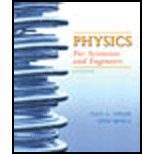
(a)
The resistance for small reverse-bias voltages.
(a)
Answer to Problem 54P
The resistance for small reverse-bias voltages is
Explanation of Solution
Given:
The saturation current is
The value of
Formula used:
The expression for Ohm’s Law is
Here,
The expression for current in semiconductor is,
Calculation:
For small reverse-bias voltages i.e
The expression for current in semiconductor is then reduced to,
The expression for Ohm’s Law is then derived as,
The resistance is further calculated as,
Conclusion:
Therefore, the resistance for small reverse-bias voltages is
(b)
The resistance for reverse bias of
(b)
Answer to Problem 54P
The resistance for reverse bias of
Explanation of Solution
Formula used:
The resistance for reverse bias of
Calculation:
Evaluating the term
The resistance for reverse bias of
Conclusion:
Therefore, the resistance for reverse bias of
(c)
The resistance for a
(c)
Answer to Problem 54P
The resistance for forward bias of
Explanation of Solution
Formula used:
The resistance for forward bias of
Calculation:
Evaluating the term
The resistance for reverse bias of
Current is calculated from Ohm’s Law,
Conclusion:
Therefore, the resistance for forward bias of
(d)
The AC resistance for a
(d)
Answer to Problem 54P
The AC resistance for forward bias of
Explanation of Solution
Formula used:
The resistance for forward bias of
The AC resistance is expressed as,
Calculation:
The AC resistance is calculated as,
The calculation is further simplified as
Conclusion:
Therefore, the AC resistance for forward bias of
Want to see more full solutions like this?
Chapter 38 Solutions
Physics for Scientists and Engineers, Vol. 1
- Why does the horizontal Line in the graph in Figure 9.12 suddenly stop at the Fermi energy? Figure 9.12 (a) Density of state for a free electron gas; (b) probability that a state is occupied at T = 0 K; (c) density if occupied states at T = 0 k.arrow_forwardQ. 2. In a P-N junction diode, width of depletion layer is 0· 54m and potential barrier is 0-5V. Calculate the barrier electric field.arrow_forwardThe voltage of a BYZ83 type Zener diode is given as V, = 20v, power P, = 300mW, and Zener resistance R, = 20. a) Find the maximum current(Imm) that can flow through.arrow_forward
- A silicon n+-p-n transistor has impurity concentrations of 1019, 1018, and 1017 cm 3 in the emitter, base, and collector, respectively. Calculate the collector current density, Jc in the transistor with VF = 0.2V and neutral base width equal to 5 x 103 cm. Next, find the collector current density, Jc for the 2nd design nt-p-n transistor that the neutral base width has been decreased by 20%.arrow_forward1.0 Biased PN Junctions Consider two PN diodes, A and B as depicted below. Suppose the junction area for each diode is 1.0 x10-8 cm² (1 square-micron) P-doped N-doped N = 1016 1/ cm3 Ng = 1017 1/cm³ X, *po Vo в P-doped Na = 1018 1/cm3 N-doped Ng = 1017 1/cm3 Х ро Xno V. a) At VD =0 Volts, which diode has the wider total depletion region width (value (in microns) and what is it? b) At Vp =0 Volts, in which diode the magnitude of the maximum electric field in the depletion region is the largest and what is its value (in V/cm)? c) Under a reverse bias Vp <0, which diode will breakdown first (i.e. at a smaller magnitude of the negative bias).arrow_forwardA full-wave bridge rectifier is constructed using 4 germanium diodes, each with a forward voltage drop of 0.3 V. The rectified waveform is described by the function vout(0) = V, sin 0 - 2 Vp where 8 = sin1 (2Vp/V,). Use integration to determine the exact average value of Vout for V, = 1.5, 2, 2.5, 3, 3.5, 4, and 4.5 V (using Excel or Matlab will speed up this process considerably). Then use the estimation formula (0.636 V, - 2 Vp) to determine the average value for each value of V, above and find the percent difference between the exact and estimated values for each V, value. At what value of V, does the percent error become greater than or equal to 5%? OVs = 2 V OVs - 1.5 V OVs - 2.5 V OVs - 3Varrow_forward
- Question 5. A pure resistive R ohm output is connected to the output of the three-phase Bridge Rectifier.resistor is connected and provides 250 DC output voltage, 50A load current,frequency is 50 Hertz.(d) TU Value(e) Reverse Peak Voltage (PIV) of each diode(f) Find the maximum value of the current flowing through the diode.arrow_forwardQ': Assuming the ideal diode model (VOn=0 V), calculate VoUT for the circuits in Figures (b) and (c) for the following input voltages (your answers should be in a table similar to that given below) 4k VOUT,b νουτε v20 v20 4k (b) (c) V1 V2 5arrow_forwardThe maximum wavelength of light that a certain silicon photocell can detect is 1.11 mm. (a) What is the energy gap (in electron volts) between the valence and conduction bands for this photocell? (b) Explain why pure silicon is opaque.arrow_forward
- (a) At what reverse bias voltage does the reverse-bias current in a silicon pn junction diode reach 90 percent of its saturation value? (b) What is the ratio of the current for a forward-bias voltage of 0.2 V to the current for a reverse-bias voltage of 0.2 V?arrow_forwardSilicon is doped with phosphorus atoms (column V of Mendeleev table) with a concentration of 1018 cm-3 a- What is, at 27 °C, the electron density in doped Si. Use this result to derive the hole density. Which type of semiconductor is obtained? b- Calculate, at 27 °C, the position of the Fermi level EF and plot the band diagram.arrow_forward
 Modern PhysicsPhysicsISBN:9781111794378Author:Raymond A. Serway, Clement J. Moses, Curt A. MoyerPublisher:Cengage Learning
Modern PhysicsPhysicsISBN:9781111794378Author:Raymond A. Serway, Clement J. Moses, Curt A. MoyerPublisher:Cengage Learning University Physics Volume 3PhysicsISBN:9781938168185Author:William Moebs, Jeff SannyPublisher:OpenStax
University Physics Volume 3PhysicsISBN:9781938168185Author:William Moebs, Jeff SannyPublisher:OpenStax

